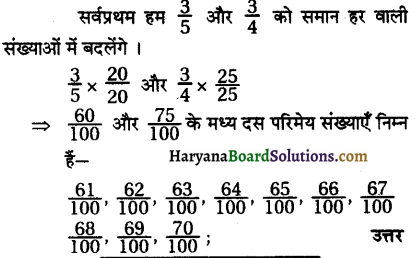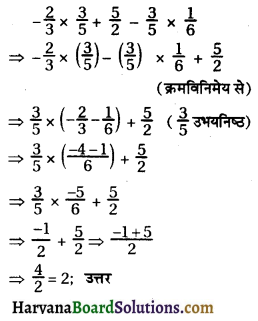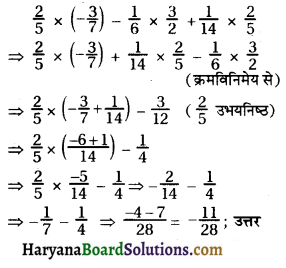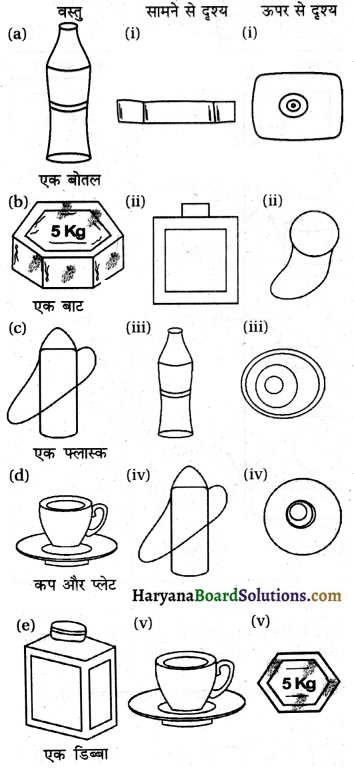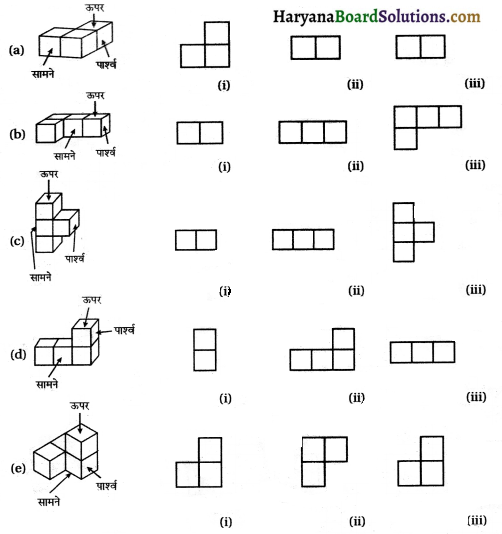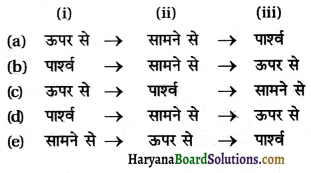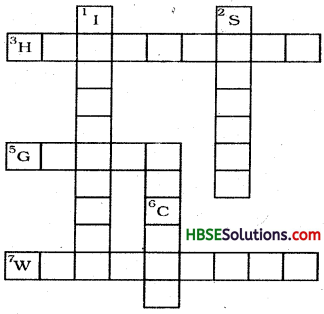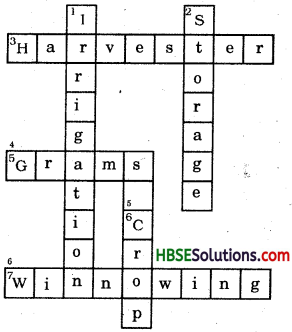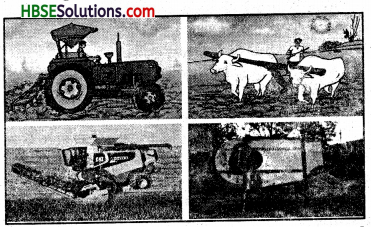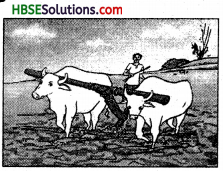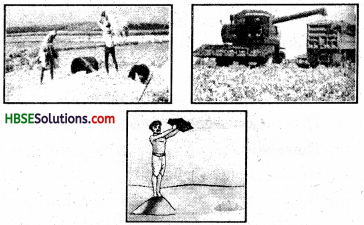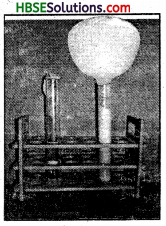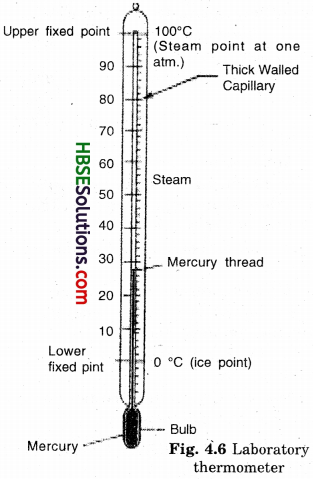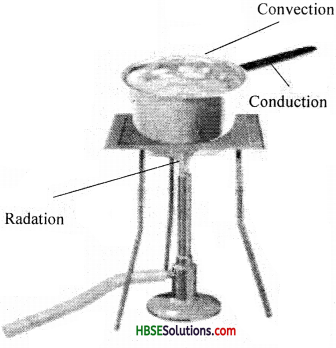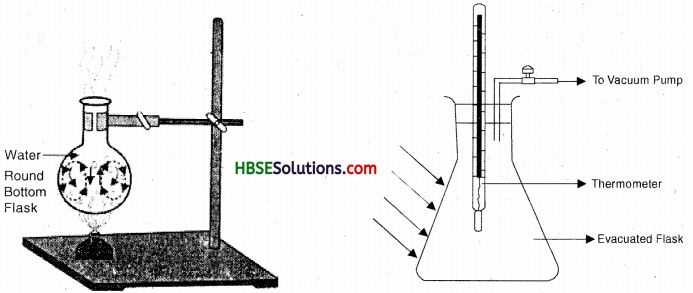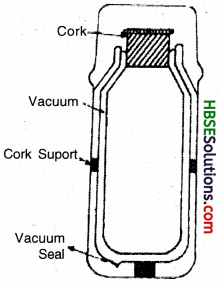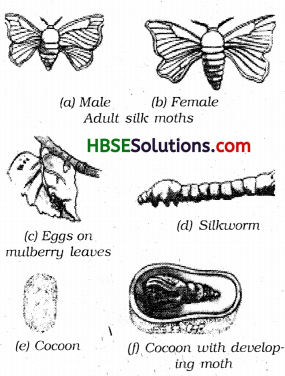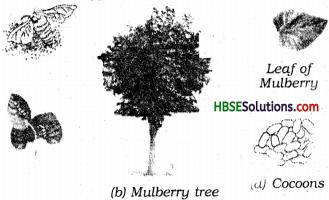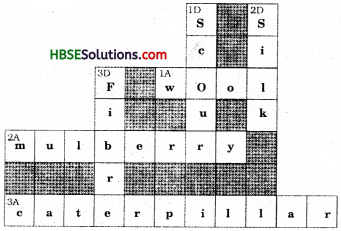Haryana State Board HBSE 8th Class Science Solutions Chapter 7 Conservation of Plants and Animals Textbook Exercise Questions and Answers.
Haryana Board 8th Class Science Solutions Chapter 7 Conservation of Plants and Animals
HBSE 8th Class Science Conservation of Plants and Animals Textbook Questions and Answers
Question 1.
Fill in the blanks:
(a) A place where animals are protected in their natural habitat is called ………….. .
(b) Species found only in a particular area is known as ………….. .
(c) Migratory birds fly to far away places because of …………. changes.
Answer:
(a) wildlife sanetuary
(b) Endemic species
(c) climate.
Question 2.
Differentiate between the following:
(a) Wildlife sanctuary and biosphere reserve.
(b) Zoo and wildlife sanctuary.
(c) Endangered and extinct species.
(d) Flora and fauna.
Answer:
(a) Wildlife sanctuary is a place where wild animals are protected and preserved. Here poaching or capturing any animal is strictly prohibited. Biosphere reserves are the protecting areas meant for only conservation of biodiversity i.e. animals and plants and even the microorganisms. It also helps to maintain the culture of that area. It contains many wildlife sancturies, national parks.
(b) Zoos are smaller places having some animals protected for the public view, while wildlife sancturies protect and conserve wild animals in their natural habitats. They are spread in vast areas.
(c) Endangered species are those species which are at the verge of extinction and which are required to be protected and conserved, while extinct species are those which no more exist on the earth.
(d) Flora is the term used for wide variety of plants while fauna is used to refer to all the varieties of animals.

Question 3.
Discuss the effects of deforestation on the following:
(a) Wild animals
(b) Environment
(c) Villages (Rural areas)
(d) Cities (Urban areas).
(e) Earth
(f) The next generation.
Answer:
(a) Wild animals:
When forests are cut, they leave many wild animals unsheltered. Their habitat is snatched away from them and they are left to die without their natural shelter.
(b) Environment:
Environment is adversely effected by deforestation as ecological balance is disturbed. Carbondioxide is not absorbed by plants and it gets accumulated to cause global warming.
(c) Villages (Rural areas):
Villages are depended upon forests to large extent. They are closely related to forests. Some adjoining villages have to face the wrath of wild animals as unhabitated animals run to nearby villages and cause danger to them. Morever they are devoid of other benefits like fruits, fuel, wood etc. they get from forests.
(d) Cities (Urban areas):
Cities are not directly effected by the cutting of forests because they are away from forests. But changes in climate effect cities. Calamities like flood and droughts do not spare cities.
(e) Earth:
Earth is the worst effected by deforestation. Its fertile land gets converted into deserts and its temperature rises. Its environment and climate changes.
(f) The Next generation:
The next generation will not be able to see many beautiful and attractive flora and fauna. They will not get a clean and cool environment. They will have to breath poisonous gases and have to live in jungles of concrete.
Question 4.
What will happen if:
(a) we go on cutting trees.
(b) the habitat of an animal is disturbed.
(c) the’top layer of soil is exposed.
Answer:
(a) We go on cutting trees:
If we go on cutting trees, the earth will loose its top fertile soil and get converted to desert. The ecological balance will get disturbed and floods and droughts will become more frequent. Many animals will loose their shelter and there will be a scarcity of things like fruits, paper, etc. we get from forests.
(b) When the habitat of an animal is disturbed, it becomes unprotected and unconserved. It becomes prone to extinction and if not conserved and protected, it will stop to exist anymore on the earth.
(c) When the top layer of the soil is exposed, the humus is lost and fertile soil gets converted into dry sand particles. It is called desertification.
Question 5.
Answer in brief:
(а) Why should we conserve biodiversity?
(b) Protected forests are also not completely safe for wild animals. Why?
(c) Some tribes depend on the jungle. How?
(d) What are the causes and consequences of deforestation?
(e) What is Red Data Book?
(f) What do you understand by the term migration?
Answer:
(a) We should conserve biodiversity to save it from becoming extinct.
(b) Protected forests are also not completely safe for wild animals because the poachers have found access in these areas an,d still kill the wild animals inside these protected areas.
(c) Some tribes are totally dependent on forests for their food, shelter, clothes and other requirements.
(d) Causes of the deforestation are growing urbanization and industrialization. Consequences are the desertification and natural calamities. It has also rendered many species of plants and animals unprotected and unconserved.
(e) Red Data Book is the record book and source book of all the endangered animals and plants. Different record books are maintained for endangered animals and endangered plants.
(f) The term migration means the phenomenon of periodical movement of a species of brids from its owu habitat to some other habitat due to changes in climate. It is for the purpose of breeding and other specific purposes.
Question 6.
In order to meet the ever- increasing demand in factories and for shelter, trees are being continually cut. Is it justified to cut trees for such projects? Discuss this in your class and prepare a brief report.
Answer:
It is not justified to cut forests for any project. We not only cut forests, we snatch away shelters from many plants, animals and birds. They also disturb the ecological balances and cause many natural calamities. So, we should preserve and protect our forests.

Question 7.
How can you contribute to the maintenance of green wealth of your locality? Make a list of actions to be taken byyou.
Answer:
We can grow new plants in our locality. Take turns to water them and take care of them. The existing plants should be properly nourished. All the residents should be taught about the coming dangers due to deforestation like global warming etc. They should be encouraged to help in the maintenance of green wealth of our locality.
Question 8.
Explain how deforestation lead to reduced rainfall.
Answer:
Deforestation leads to reduce rainfall because plants are the main agents to maintain the water cycle in the environment. Plants will not absorb water from the soil and will not evaporate water from their leaves to form clouds. If clouds will not be formed then how can we expect rainfall.
Question 9.
Find out about national parks in your state. Identify and show their location on the outlipe map of India.
Answer:
For self attempt.
Question 10.
Why should paper be saved? Prepare a list of the ways by which you can save paper.
Answer:
Paper is manufactured by using, pulps of tree bark. If we will keep on cutting forests indiscriminately, then where will we get pulp from. We should save paper to protect our trees, because paper can be recycled to make- new paper. We should not throw papers here and there. Newspapers, old books, notebooks and other papers should be collected and sold to kabadiwala, so that he can further supply it for recycling.
Question 11.
Complete the word puzzle:
Down .
1. Species on the verge of extinction.
2. A book carrying information about endangered species.
5. Consequence of deforestation.
Across
1. Species which have vanished.
3. Species found only in a particular habitat.
4. Variety and variability of a plant, animal and microorganisms.

Answer:

Extended Learning – Activities And Projects
1. Plant at least five different plants in your locality during this academic year and ensure their maintenance till they grow.
Answer:
For self attempt.
2. Promise yourself that this year you will gift at least 5 plants to your friends and relatives on their achievements, or on occasions like birthdays. Ask your friends to take proper care of these plants and encourage them to gift plants to their friends on such occasions. At the end of the year count the plants that have been gifted through this chain.
Answer:
For self attempt.
3. It is justified to prevent tribals from staying in the core area of the forest? Discuss the matter in your class and note down the points for and against the motion in your notebook.
Answer:
It is not justifiable in my Qpinin to prevent triabls from the core area of a forest. It is their natural habitat. They are not any threats to animals and plants as their life is centred around plants and animals. They don’t destroy forest or kill animals unnecessarily. Forest for them is an important as for other animals and plants.
4. Study the biodiversity of a park nearby. Prepare a detailed report with photographs and sketches of the flora and fauna.
Answer:
For self attempt.

5. Make a list of the new information you have gathered from this chapter. Which information did you find the most interesting and why?
Answer:
(i) We have learnt how deforestation is destoryed biodiversity.
(ii) We have learnt about the actual meaning ofbiodiversity.
(iii) We have also gathered new information about extinct and endangerous animals.
(iv) We did not know anything about Red Data Book-but know we have learnt about it through this lesson.
6. Make a list of various uses of papers. Obseve currency notes carefully. Do you find any difference between a currency paper and paper of your notebook? Find out where currency paper is made.
Answer:
Paper is very useful for us.
(i) Our book and notebooks are all made up of paper.
(ii) Most of our currency is made up of paper.
(iii) All legal information and other important information are encoded on papers.
(iv) Paper is used to make bags, containers, package materials, etc. The paper used to make currency is stiffer than the normal paper and is transparent to some extent.
7. Karnataka Government had launched “Project Elephant” to save Asian elephants in the state. Find out about this and other such campaigns launched to protect threatened species.
Answer:
For self attempt.
Activities
Activity No. 7.1
Add more causes of deforestation to your list and classify them into natural and man-made.
Answer:
Natural causes of deforestation:
(i) lightning fires.
Man-made causes of deforestation:
(i) animal grazing.
(ii) Wood for fuel making houses.
(iii) Wood for manufacuring of paper.
Activity No. 7.2
Animal life is also affected by deforestation. How? List the points and discuss them in your class. ,
Answer:
(i) Animals loose their shelter as trees are out.
(ii) There is shortage of food for animals due to deforestation.
(iii) Animals become easy prey to hunters and bigger animals.
(iv) Food chains are disturbed.
(v) Animals have to bear the bad effects of natural calamities.
Activity No. 7.4
List the factors disturbing the biodiversity of your area. Some of these factors and human activities may disturb the biodiversity unknowingly. List these . human activities. How can these be checked? Discuss in your class and write a brief report in or notebook.
Answer:
Main factor affecting biodiversity of an area is cutting of trees and using the forest land for construction and industrialization. Excessive rains or droughts also offer the biodiversity of an area. Certain human activities which give rise to polluting end products also disturb the biodiversity unknowningly. When plants and animals do get clean environment they either fall ill or die, thus disturbance in biodiversity.
Activity No. 7.7
Visit a nearby zoo. Observe the conditions provided to the animals. Were they suitable for the animals? Can animals live in artificial setting instead of their natural habitats? In your opinion, will the animals be confortable in a zoo or in their natural habitat?
Answer:
Conditions provided in a zoo can never be compared with the natural habitat. The condition in a zoo are not exactly suitable for animals, although it is tried best to provide best living conditions to the animals in a zoo. But in my opinion animals be most comfortable in their natural habitat.

HBSE 8th Class Science Conservation of Plants and Animals Important Questions and Answers
Very Short Answer Type Questions
Question 1.
What is cutting of forests called?
Answer:
Deforestations
Question 2.
Write any one cause of deforestation.
Answer:
Industrialization.
Question 3.
Name any one natural cause of deforestation.
Answer:
Forest fires.
Question 4.
Write any one consequence of deforestation.
Answer:
Increasing temperature of earth.
Question 5.
What is the process of conversion qf fertile soil into sand called?
Answer:
Desertification.
Question 6.
What are places where wild animals are protected called?
Answer:
Wildlife sanctuary.
Question 7.
What is the part of earth, which supports the biodiversity called?
Answer:
Biosphere reserve.
Question 8.
Name two wildlife sanctuaries hosted by Panchmarhi biosphere reserve.
Answer:
Bori and Panchmarhi.

Question 9.
What do you mean by Flora?
Answer:
All plants found in a particular area.
Question 10.
What do you mean by Fauna?
Answer:
All animals in a particular area.
Question 11.
What are species found only in a restricted area called?
Answer:
Endemic species.
Question 12.
Name any fauna of Panchmarhi Biosphere,reserve.
Answer:
Bison.
Question 13.
Name any three endangered species protected in our wildlife sanctuaries.
Answer:
Black buck, white eyed buck, golden cat.
Question 14.
What do National Parks preserve?
Answer:
Flora, fauna, landscape and historical objects.

Question 15.
Which is the first Reserve Forest of India?
Answer:
Satpura National Park.
Question 16.
Which prehistoric evidences of human life are found in Satpura National Park?
Answer:
Rock shelters of primitive humans.
Question 17.
When was Project Tiger launched?
Answer:
1st April, 1973.
Question 18.
What are the animals facing the danger of extinction are called?
Answer:
Endangered animals.
Question 19.
Name any one extinct animal.
Answer:
Dinosaurs.
Question 20.
Name the record book having records of all endangered animals and plants.
Answer:
Red Data Book.
Question 21.
Name some migratory birds.
Answer:
Surkhab, Bar Headed Goose, Great Cormorant.

Question 22.
How many times a paper can be recycled?
Answer:
5-7 times.
Question 23.
What do we call the restocking the plants by growing new plants?
Answer:
Reforestation.
Question 24.
What is plantation of new plants called?
Answer:
Afforestation.
Question 25.
What is the revised Forest Policy of 1952 called?
Answer:
Forest Act, 1980.
Short Answer Type Questions
Question 1.
What do you mean by deforestation?
Answer:
Indiscriminate cutting of forests for urbanization and industrialization is called deforestation. In simple words, deforestation means to clear the forests and use the land for other purposes.

Question 2.
Write some natural causes of deforestation.
Answer:
Natural causes of deforestation are those causes which are not initiated by human beings. Natural phenomenon like lightening on forests cause major forest fires, which can bum a large area of forests. Forest fires due to intense heat cause spontaneous combustion and bums a vast area of forest. Similarly, floods and severe droughts also cause damage to forests.
Question 3.
Write a few consequences of deforestation.
Answer:
Deforestation. has dangerous consequences which prove fatal for wildlife and human life. It gives rise to severe droughts and floods. It converts the fertile land into desert. It increases the temperature of the earth which causes melting of polar ice and glaciers. Many important species of plants, animals and birds become extinct and other stands at the verge of extinction.
Question 4.
How deforestation reduces rainfall?
Answer:
Deforestation disturbs the water cycle and reduces the rainfall. Increased amount of carbondioxide in environment increases the temperature of the earth. Which means there is less amount of water left on the earth. This reduces the evaporation of the water to form clouds thus reduced rainfall.
Question 5.
What do you mean by biodiversity?
Answer:
Biological diversity means the variety of living things existing on earth and their inter-relationship, as well as their relationship with the environment. In other words, variety of plants, animals and microorganisms generally found in an area is called its biodiversity.
Question 6.
What do you mean by endemic species?
Answer:
Species of animals and plants which are only found in a particular geographical area is called endemic species. These plants and animals cannot be found in any other geographical area e.g., wild mango arid gaint squirrel is endemic species of Panchmarhi.
Question 7.
What do you mean by wildlife sanctuaries?
Answer:
Wildlife sanctuaries are the protected areas where wild animals are protected and conserved. The wild animals are provided with their natural habitat. Their poaching and capturing is strictly prohibited m these protected areas.
Question 8.
What is a National Park?
Answer:
National Park is the protected vast area which conserves animals, plants, landscapes and even the historical objects. They are very large areas and can even protect whole sets of ecosystems in them. India has many such National Parks like Satpura National Park, Kaziranga National Park, etc.

Question 9.
What are the endangered and extinct animals?
Answer:
Endangered animals are those which are facing the danger to their existence. They are threatened to stop existing on the earth, if not saved. The extinct animals are those which do not exist any more on the earth e.g. Dinosaurs.
Question 10.
What is ecosystem?
Answer:
An ecosystem comprises of all the plants, animals, microorganisms in a particular area alongwith its non-living components like climate, soil, river, deltas etc.
Question 11.
What do you know about Project Tiger?
Answer:
Project Tiger was launched by Gqf*rtnment of India on 1st April, 1973 to enusre the maintenance of a viable populati on of tigers in our country. Tigers are one of the endangered species, so to preserve it Project Tiger was launched.
Question 12.
Why do birds migrate?
Answer:
Birds migrate from one place to another due to change in climate and for specific purposes like breeding etc. When weather in their natural habitat becomes cold they migrate to other lands covering long distances to lay eggs.
Question 13.
How does recycling of paper help preserving trees?
Answer:
Paper is made from the bark of trees. If used paper is recycled to make new papers, it means we do not have to cut more trees. So, recycling paper means protecting trees.
Question 14.
What do you mean by Habitat?
Answer:
Each species can live in particular environment according to their characteristics. So, the natural surroundings of a plant or animal species where they can grow, reproduce and live comfortably are called habitats, e.g. a lion can live in jungle, but not in a city. So jungle is the habitat of the lion.
Long Answer Type Questions
Question 1.
What is Deforestation? Write its causes.
Answer:
Deforestation means indiscriminate cutting of trees in forest. Forest lands are cleared to be used for urbanisation and industrialization.
Following are different causes of deforestation:
(i) Forest land is used for urbanization. As population is growing, so is growing the need for houses. So more and more land is required.
(ii) With growing population, industries are also growing. So the cleared land is used to set-up factories and industries.
(iii) Wood of forest is used for making furniture, doors, windows of buildings etc.
(iv) Wood is cut to use as fuel for cooking.
(v) Some natural causes like forest fires etc. also cause destruction of forests.

Question 2.
What are the consequences of deforestation? Explain.
Answer:
Deforestation has dire consequences. Following are the consequences of deforestation:
(i) Deforestation snatches away the natural habitat of many animals, plants and birds. It puts many species in endangered zone and many get extinct.
(ii) Deforestation causes natural calamities like floods, drought etc.
(iii) Reduced rainfall and increase in earth’s temperature has caused problems like Global warming.
(iv) Increased amount of carbondioxide and other gases pollute environment.
(v) Oxygen level is decreased as well as the water level.
(vi) Fertile top layer of soil gets converted into desert.
Question 3.
What is done for the conservation of wildlife?
Answer:
Various measures are taken to conserve wildlife. Reserved and protected areas like Biosphere reserve, Wildlife sanctuaries and National parks are formed.
Biosphere Reserves are the areas which support biodiversity and culture of the reserved area. Biosphere Reserve is a vast area which contains many other protected areas.
Wildlife Sanctuaries are the areas where wild animals are conserved and protected. It is the area which is restricted and activities like killing of animals and capturing of animals are strictly prohibited.
National Parks: National Parks are meant to protect and preserve flora, fauna, landscapes and historical objects of an area. They not only protect the living organisms, but also the non-living things of that particular area.
Question 4.
What do you mean by Endemic Species? Write about any three species endemic to India.
Answer:
Species of animals and plants comfined to certain specific geographical areas are called endemic species. Following are the three species of animals endemic to India.
(i) Lion-tailed macaque:
This animal got his name from its tail which is 25 cm in length and has a tuft at the end like that of lion’s which is black in colour. It is endemic to south-west India an is one of the most threatened primates.
(ii) Asiatic lion:
Asiatic lion is now endemic to Gir National Patk only as it is believed that the last remnants of this species are found in Gir National Park in Gujarat only.
(iii) Nilgiri ibex:
These stocky goats possessing short coarse fur and a bristly main are endemic to Nilgiri Hills and the Southern postion of the Western Ghats range in Tamil Nadu and Kerela. It is actually called Nilgiri Thar and Nilgiri ibex is its local name.
Question 5.
What is migration and why animals migrate?
Answer:
Movements of animals in large number from one place to another place to escape unfavourable conditions is called migration. Animals migrate for specific purposes. When the purpose is solved, they usually come back to their endemic area.
Migration can be due to unfavourable environmental conditions, eg. The Arctic Tern migrate to Antarctic to spend its winlers. Some birds of colder regions migrate to Asiatic countries during winters. This type of migration is called seasonal migration which occur in many species of insects, birds, marine mammals and herbivorous mammals.
Migration is also done for better food or water availability in other regions due to temperature and other climatic conditions.
Some species of animals and birds also migrate for the purpose of reproduction e.g. fresh watereeds go to saltwaters from freshwater to lay eggs.

Question 6.
What is poaching? How is it done by anti social elements and for what purpose?
Answer:
Illegal hunting of animals is called poaching. Anti-social element some time create a nexus with the forest staff for poaching; They hunt the animals for selling their skin, horn, fur and hides.
All valuable parts of these animals are used for various purposes and are sold at very high prices.
Uses for ornaments: The bones and other parts like trunks of elephants etc. are used to make ornaments.
Uses in medicines: The horns and bones of some animals like rhinoceros and tigers are used to prepare some traditional medicine specially in Asian countries.
For wall hanging and clothings: The skin, fur and hides are used for the clothing. Mufflers, coats, jackets, skirts etc. are made using leather and fur of the animals like cats, minks, bears foe fur, skin of alligators and snakes and deer and cattle are killed for leather.
Question 7.
Write a short note op migratory birds.
Answer:
Migratory birds are those birds which migrate from their natural habitat to far off areas for breeding. When the natural habitat o.f these birds become very cold, they fly off to distant lands to lay eggs, as climate there is suitable for their breding. They always fly to a specific area every year at a specific period. They migrate in groups to escape the inhospitable climate of their natural habitat.
Birds like Surkhab fly to India from Malyasia. Other birds like Bar Headed Goose, Great Cormorant etc. are also migratory birds.
Question 8.
Recycling of paper helps to protect forest and environment. Explain.
Answer:
Paper is made from trees. Innumerable trees are cut to manufacture paper. If we recycle used paper, we will not have to cut trees to manufacture new paper. Each paper can be recycled 5-7 times and can be used. If we do not throw paper here or there and collect it to be sold to the Kabadiwala, we sire saving our green wealth. It will also save the chemicals used to prepare paper and also the energy used for preparing it. The wastage mid garbage produced during this process will also be reduced and environment will remain clean.
Question 9.
How can we save CHIT green wealth?
Answer:
Our forests are our wealth. We should not destory them but conserve them. To conserve our forests, first of all we should stop cutting them. We should plant as many plants as we cut, so that the number of trees remain unchanged. People should be made aware of the bad effects of deforestation and they should be made familiar with the advantages of the trees for us. Community plantation programmes should be encouraged. Students should be encouraged to plant one plant every year. Plantation of trees is not sufficient. They need proper look after too. So, the tree we plant, should be nourished and taken care of.
Conservation of Plants and Animals Class 8 HBSE Notes
1. A vast variety of plants and animals exist on earth.
2. Deforestation is a threat to the survival of these plants and animals as major varieties of plants and animals are present in forests.
3. Indiscriminate cutting of forests is called deforestation. Land cleared by deforestation is used for other purposes too.
4. Trees cut from these forests are used to make furnitures, papers, houses and is also used as . fuel.
5. Deforestation causes floods, droughts, infertility of soil and many other natural calamities.
6. Soil looses humous due to deforestation and becomes sand, thus deforestation converts a fertile land into a desert and it is called desertification.
7. We should conserve our forests by planting more and more trees which is called afforestation. For conservation of animals; wildlife sancturies and hational parks are formed. They give shelter to our wildlife and help to preserve our endangered species of plants and animals.
8. Variety pf life existing on earth and their inter-relation is called biodiversity. In other words biodiversity is variety of plants and animals and microorganisms generally found in a specific area. Such life is supported by the area called Biosphere.
9. Species ofplants and animals exclusively found in a restricted area are called Endemic species. They are not found in any other geographical area.
10. These species which are at the verge of extinction are called endangered species.
11. Red Data Book contains a record of the endangered species.


![]()

![]()
![]()
